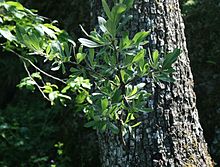Pyrus elaeagrifolia
| Pyrus elaeagnifolia | |
|---|---|

| |
| P. elaeagrifolia stem with leaves | |
| Scientific classification | |
| Kingdom: | |
| (unranked): | |
| (unranked): | |
| (unranked): | |
| Order: | |
| Family: | |
| Genus: | |
| Section: | Pyrus
|
| Species: | P. elaeagnifolia
|
| Binomial name | |
| Pyrus elaeagnifolia | |
Pyrus elaeagnifolia, also oleaster-leafed pear, is a species of wild pear plant in the genus Pyrus (Rosaceae) the specific name referring to the similarity of its foliage to that of Elaeagnus angustifolia - the so-called 'wild olive' or Oleaster.
It is native to Albania, Bulgaria, Greece, Romania, Turkey, and Ukraine's Crimea.[1] It prefers dry habitat and elevations up to 1,700 meters (5,600 ft). It grows to a height of 10 meters (33 ft). The flowers are hermaphrodite.[2] The species is highly resistant to drought and frost. It is sympatric with Pyrus pyraster. The species was first described by Peter Simon Pallas in 1793.[3]
Varieties
Known subspecies are: Pyrus elaeagrifolia subsp. elaeagrifolia (no accessions), Pyrus elaeagrifolia subsp. kotschyana, Pyrus elaeagrifolia subsp. bulgarica, and Pyrus elaeagrifolia subsp. yaltirikii.[1][4]
References
- ^ a b GRIN (May 10, 2012). "Pyrus elaeagnifolia Pall". Taxonomy for Plants. National Germplasm Resources Laboratory, Beltsville, Maryland: USDA, ARS, National Genetic Resources Program. Retrieved January 29, 2014.
- ^ "Pyrus elaeagnifolia - Pall". Plants for a Future. Retrieved January 29, 2014.
- ^ Hanelt, Peter; Büttner, R. (2001). Mansfeld's Encyclopedia of Agricultural and Horticultural Crops. Berlin: Springer-Verlag. p. 465. ISBN 3-540-41017-1.
- ^ Kole, Chittaranjan (2001). Wild Crop Relatives: Genomic and Breeding Resources: Temperate Fruits. Berlin: Springer-Verlag. p. 149. ISBN 978-3-642-16056-1.
External links
 Media related to Pyrus elaeagrifolia at Wikimedia Commons
Media related to Pyrus elaeagrifolia at Wikimedia Commons Data related to Pyrus elaeagrifolia at Wikispecies
Data related to Pyrus elaeagrifolia at Wikispecies

